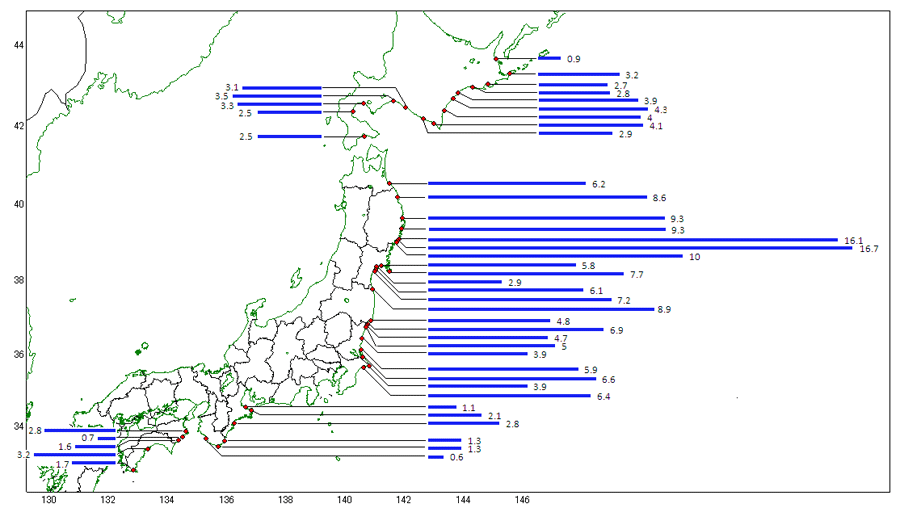「どんな災害だったの?」
おぼえられる範囲でまとめた
東日本大震災のこと。
“How bad was the disaster?”
Tohoku Earthquake Statistics: A Simple Guide
「東日本大震災って、どんな災害だったの?」
当時のことをきちんと知らない人、
たとえば外国から来た人や小学生に問われたとき、
答えられる自分たちでいたいと思いました。
暗記する必要なんてないけど、知っていたい。
東日本大震災についての概要や数字、
あらためてまとめてみました。
People living outside Japan may not know all the details of the natural disaster that struck Japan in 2011. We’ll remember that day by gathering simplified statistics of the Tohoku Earthquake (known as the Great East Japan Earthquake in Japan) to provide a source for easy referral.
※以下のデータは、総務省消防庁の
「平成23年(2011年)東北地方太平洋沖地震(東日本大震災)の被害状況」
(令和7年3月1日現在)、「東日本大震災記録集」、
復興庁「被災者等の状況」(令和7年3月4日)をもとに、
2025年3月10日時点での最新情報を各府省庁のページで確認したものです。
*The following information is from “Report on the 2011 earthquake off the Pacific coast of Tohoku” (Updated March 1st, 2025) (Japanese), “Great East Japan Earthquake Record Collection” (Japanese) by the Fire and Disaster Management Agency (Japanese), and “Report on the number of evacuees in Japan” (Updated March 4th, 2025) (Japanese), by the Reconstruction Agency (Japanese), last accessed on March 10th, 2025.
2011年3月11日(金)14時46分に
マグニチュード Mw 9.0、最大震度7の大地震が起こりました。
震源の三陸沖に(仙台市の東方70km)、
東北地方を中心に2〜3分以上揺れました。
地震につづけて大きな津波が起こり、
15時過ぎから16時ごろにかけて、
東日本の太平洋側の地域が大きな被害を受けました。
津波の高さは9m以上といわれ、建物の5階まで浸水した地域もありました。
死者は1万5900人。そのほとんどが津波によるものです。
現在も2520人の方が行方不明で、捜索活動が続けられています。
震災によって避難した人は最大で約47万人。
現在も2万7615人の方が仮設住宅などで暮らしています。
東日本大震災は、地震そのものの影響に加えて、
津波、火災、停電、そして別にまとめた福島第一原子力発電所の事故など、
多岐にわたる被害をもたらした、大規模な複合災害だといえます。
| ※このデータは2025年3月10日時点のものです。 | |||||||
| 発生日時 | 2011年3月11日(金)14時46分 | ||||||
|---|---|---|---|---|---|---|---|
| マグニチュード | Mw 9.0 | ||||||
| 震度 |
|
||||||
| 最大波高 | 9.3m以上(福島県相馬) | ||||||
| 死者数 | 1万5900人 | ||||||
| 行方不明者数 | 2520人 | ||||||
| 避難者数 | 2万7615人 (ピーク時は約47万人) |
||||||
もっとくわしく知りたい方は、以下のページをご参照ください。
総務省消防庁
東日本大震災記録集
福島第一原子力発電所事故のこと。
2011年3月11日の地震と津波によって
福島第一原子力発電所が停電。
高温になった核燃料を冷やすのに必要な電源が喪失し、
燃料を冷やせなくなりました。
原子炉内の水がどんどん蒸発していき
燃料が露出して融解を起こしてしまいます(メルトダウン)。
その結果、大量に発生した水素が爆発して建屋は大破。
放射性物質も大気、土壌などへ放出されました。
この福島第一原子力発電所事故は、
原子力事故・故障の評価尺度である
国際原子力事象評価尺度(INES)において
「レベル7(深刻な事故)」という
最も危険性が高い事故とみなされています。
現在も原子炉の冷却は続いており、
6基ある原子炉はすべて将来的な廃炉が決定しています。
On Friday, March 11th, 2011, at 2:46 PM local time, a magnitude 9.0 earthquake hit East Japan, and registered the highest level of 7 on the Japanese seismic intensity “Shindo” scale. The epicenter was located off the Sanriku Coast of Japan, 45 miles east of Sendai City. The violent tremors lasted over three minutes, with the strongest tremors in the Tohoku region. The earthquake triggered a large tsunami which reached the east coast of Japan along the Pacific Ocean between 3 and 4 PM, causing catastrophic damage. The tsunami waves reached up to 30 feet tall, with some areas flooded up to the fifth floor in buildings. 15,900 people died, most drowned in the tsunami. To this day, 2,520 people are still missing, and search efforts are ongoing. Immediately following the disaster, many people were displaced to temporary housing, at one point reaching 470,000 people. Currently, 27,615 people are still living in temporary housing. The Great East Japan Earthquake was an unprecedented natural disaster that caused tsunamis, large-scale fires, power outages, and a nuclear disaster that all combined to present Japan with one of the most multifaceted and complex disasters it has ever had to face.
| *This data is current as of March 10th, 2025. | |||||||
| Time of Earthquake: | Friday, March 11, 2011, 2:46 PM local time | ||||||
|---|---|---|---|---|---|---|---|
| Magnitude: | 9.0 | ||||||
| Shindo (Seismic Intensity) Scale: |
|
||||||
| Maximum Tsunami Wave Height: | Over 9.3 meters / 30 feet (Soma, Fukushima) | ||||||
| Deaths: | 15,900 | ||||||
| Missing: | 2,520 | ||||||
| Current Evacuees: | 27,615 (previously 470,000) | ||||||

▲ Tsunami height was measured by water stains and marks left
behind. Numbers indicate height in meters.
Source: Japan Meteorological Agency
You can find more information below.
Fire and Disaster Management Agency
Great East Japan Earthquake Record Collection (Japanese)
Prime Minister of Japan and His Cabinet
Reconstruction following the Great East Japan Earthquake
About the Fukushima Daiichi Nuclear Disaster
The tsunami on March 11, 2011 knocked out electricity at the Fukushima Daiichi Nuclear Plant. This cut off the power necessary to cool the nuclear fuel. As a result, the water in the nuclear reactor overheated and evaporated, which exposed the fuel and led to a meltdown. Hydrogen built up during these reactions and eventually exploded, damaging the building and releasing radioactive material into the atmosphere and ground. The Fukushima Daiichi Nuclear Disaster has been rated a Level 7, “Major Accident” on the International Nuclear Event Scale. Efforts to cool the nuclear reactor are ongoing, and all six reactors at the plant are scheduled to be dismantled in the future.

▲主な地点における津波の痕跡から推定した津波の高さ。
(数字は津波を高さを示します。単位はm)
資料提供:気象庁
▲ Tsunami height was measured by water stains and marks left behind.
Numbers indicate height in meters.
Source: Japan Meteorological Agency





